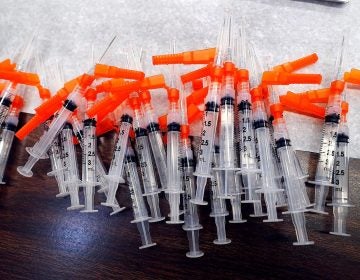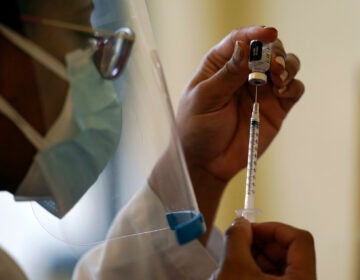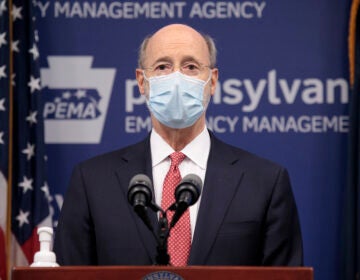Pennsylvania sees 20 percent surge in mortality rate during COVID crisis
Preliminary vital statistics show the state recorded 49,384 total deaths from any cause through the end of April. In April 2019, there were 46,521 deaths.

Pennsylvania Task Force 1 member Greg Rogalski walks amongst the beds of a Federal Medical Station for hospital surge capacity set up at Temple University's Liacouras Center in Philadelphia, Monday, March 30, 2020. (AP Photo/Matt Rourke)
Are you on the front lines of the coronavirus? Help us report on the pandemic.
The total number of deaths recorded in Pennsylvania between January and April of this year increased by about 2,790 compared to 2019 –– a significant jump, but less than what has been recorded in other states.
Preliminary vital death statistics released by state health officials show that Pennsylvania recorded 49,384 total deaths from any cause through the end of April 2020. During the same time span last year, the state recorded just 46,521 deaths.
Experts attributed this year’s increase almost entirely to the impact of COVID-19.
“Given that New York and New Jersey are some of the most impacted states, I would be shocked not to see an increase in deaths in Pennsylvania,” said Andrew Noymer, an epidemiologist at the University of California, Irvine. “These numbers show that Pennsylvania is doing better than its neighbor across the Delaware.”
Most of the increase came during April, a month that saw total deaths rise 23% when compared to the same month last year.
In general, Pennsylvania has recorded largely consistent April death totals, as the state thaws out of the cold-and-flu season. In both 2018 and 2019, total deaths hovered above 11,000 for the month, according to state records. This year, April saw nearly 13,700 deaths.
The increase in excess deaths in the Keystone State represents about 500 more fatalities than the official count of COVID-19 fatalities during that same time period — 2,292.
Researcher Beth Jarosz, of the Population Reference Bureau, said that officials across the country have struggled to gauge the full toll of COVID-19 due to a variety of factors.
“There isn’t enough testing. Even with testing, one of the things we’re learning is that COVID deaths may present in ways that don’t look like COVID,” she said. “Younger people have had strokes, children can have skin rashes. Coroners are looking for respiratory deaths, but there’s an increase in deaths that no one was looking for.”
Because it’s so easy for COVID-19 deaths to be misclassified, experts across the country are beginning to use an overall count of “excess deaths” — deaths by any cause that exceed the usual number of fatalities in a given year — as a way to measure the real toll of the pandemic. That includes people who might have put off trips to the hospital in an effort to avoid infection and died not from COVID-19 but from other illnesses.
In other states with high COVID-19 infection rates, such deaths appear to have dramatically outpaced the lives saved by a drop in motor vehicle accidents and other categories in which fatalities slowed as a result of the coronavirus shutdown.
An analysis led by epidemiologists at the Yale School of Public Health found that nationally the excess death tally from COVID-19 is at least 1 ½ times the official death count. Other states have also recorded large jumps in total deaths that outpaced official COVID-19 death counts — in New Jersey, by as much as 45% and in parts of New York state by more than 30%.
Department of Health communications director April Hutchinson said that Pennsylvania’s efforts to slow the virus are working.
“We know that through social distancing mitigation efforts we have been able to slow the spread of the virus. The biggest indicator of that is that our health care system has not become overwhelmed,” she said.
However, Pennsylvania has also lagged in reporting out vital statistics and COVID deaths. Hutchinson blamed a range of factors, including the COVID-19 shutdown, delays in counting paper death certificates, and software issues for slowing the process of assembling certain data on deaths in the commonwealth.
Experts predicted that the month of May could show an even sharper increase in excess deaths, in part because it takes a long time to register deaths so data for recent weeks may be highly incomplete, and in part because there would be fewer traditional flu deaths to mask the pandemic’s impact.
Noymer said that while the overall picture now indicates that Pennsylvania had dodged some of the exponential rise in deaths seen in nearby states, the overall statistics were still grim.
“Mortality is up relative to last year, there’s no doubt about it. And it was up even relative to what COVID deaths were officially counted, which shouldn’t surprise anyone at this point,” Noymer said. “Every time we dig deeper, we find more of these COVID deaths.”
WHYY is your source for fact-based, in-depth journalism and information. As a nonprofit organization, we rely on financial support from readers like you. Please give today.



![CoronavirusPandemic_1024x512[1]](https://whyy.org/wp-content/uploads/2020/03/CoronavirusPandemic_1024x5121-300x150.jpg)




